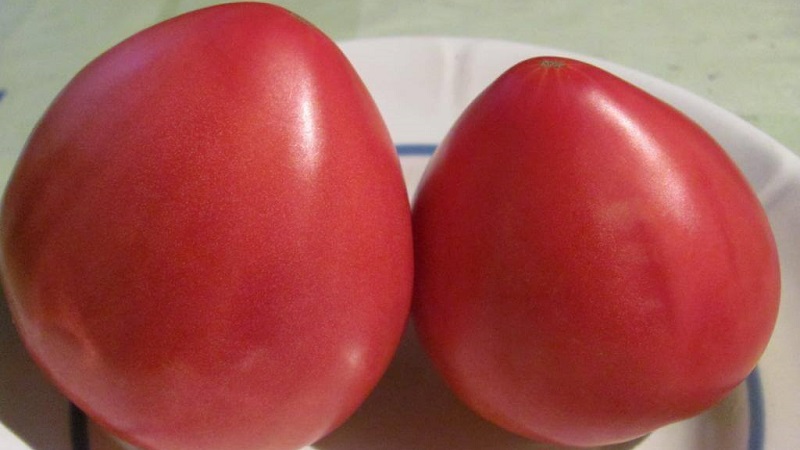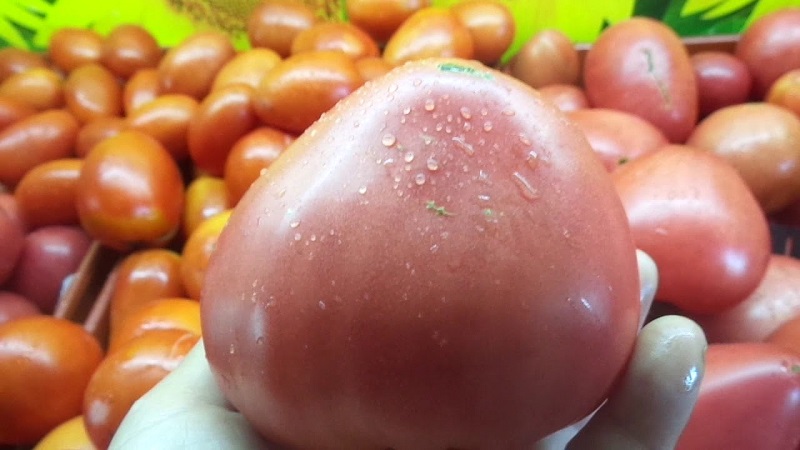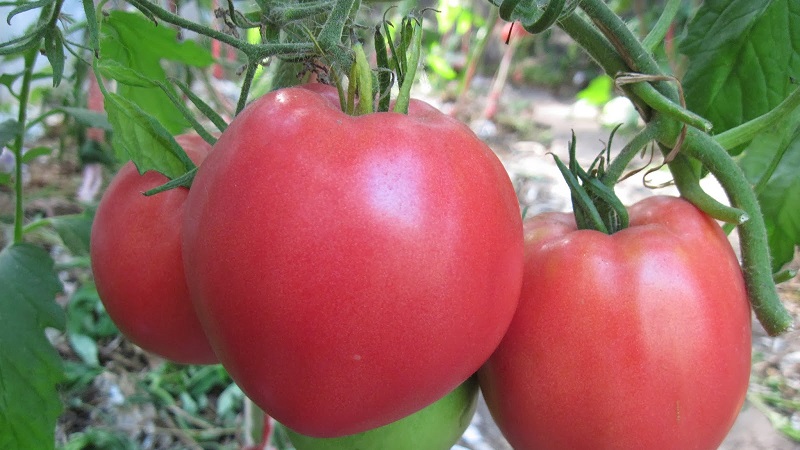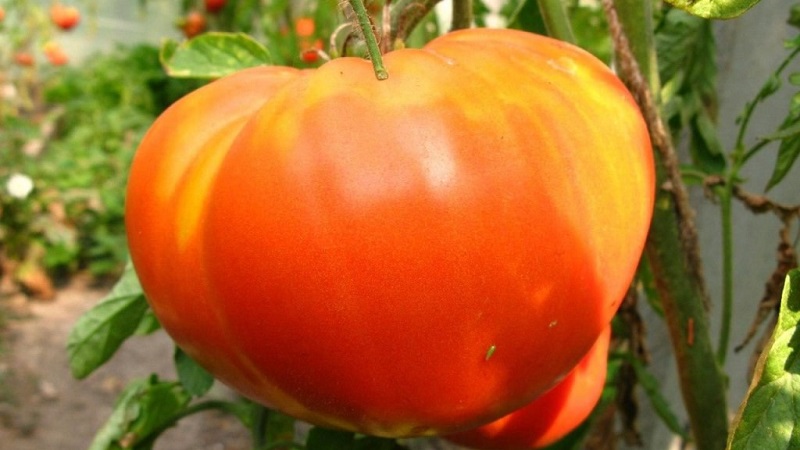One of the most favorite among gardeners tomato "Heavyweight of Siberia": resistant, early maturing and high-yielding variety
Any gardener wants to show off his harvest. If we are talking about tomatoes, then the high yield of the variety, the taste of the fruit, unpretentiousness in care, and immunity to diseases are appreciated. Unfortunately, it is not so easy to find a universal variety, so sometimes you have to sacrifice, for example, productivity in favor of high taste.
Tomato The heavyweight of Siberia is one of those varieties that compensate for their relatively low yield by unpretentiousness to growing conditions and excellent taste.
The content of the article
Description of the variety
The heavyweight Siberia was bred by Russian breeders. Its main advantage is its unpretentiousness to the climate. It grows well both outdoors and in greenhouses.
Distinctive features
The name of the variety already suggests that the fruits of this plant are large. But the plant itself is quite compact: in the greenhouse it grows no more than 1 meter in height, and in the open field - only 70-80 cm. The early maturation and high immunity are also distinctive features.
Fruit characteristics and yield
On average, the Heavyweight fruit weighs 400-600 g, some specimens reach 1 kg in weight. Ripen in 95-100 days. Tomatoes are heart-shaped, have dense pink flesh. Tomatoes are fleshy, sweet, with a slight sourness. Productivity 10-11 kg per 1 sq. m, or 3 kg from one bush.
In the photo there are tomatoes Heavyweight of Siberia:

How to grow seedlings
The preparation of seedlings of this variety does not require special skills. The procedure is not much different from the standard procedure for tomatoes.
Seed preparation
For seedlings can be used as purchased seed, and their own. Just remember that seeds from past harvests should be replaced every 5 years so that the variety does not lose its qualities.
The seeds are disinfected in a weak solution of manganese, and then kept for about 20 minutes in a solution of "Fitosporin" to accelerate their germination. The solution is prepared from 1.5 g of the preparation powder and 100 ml of water.
Capacity and soil
You can plant seedlings both in wooden boxes and in plastic cups 15-20 cm high. You can buy ready-made soil, or you can prepare it yourself. To do this, mix black soil and humus in equal proportions. You can add 1 part of peat to the same soil.
Sowing
Sowing begins in the second half of March (for subsequent planting in the greenhouse) or in April (for plants prepared for open ground). The seeds are planted to a depth of 1 cm.A distance of about 2-3 cm is left between the holes, and from 5 to 7 cm between the rows of seeds.
The seeds are carefully sprinkled with soil, and then the container is covered with polyethylene.
Growing and care
It is important to keep the seedlings in a dark and warm place. The film must be lifted periodically to provide air access and remove condensation.
Sprouts appear 10-14 days after planting. They are placed in a lighted place, but they are carefully monitored to ensure that the room is warm. During the day, the temperature should not drop below 20-22 degrees, and at night - 16-18 degrees. Draft is not allowed. Provide lighting (artificial or natural) 12-14 hours a day.
Don't forget about watering... It must be carried out every 7 days with melted or settled water. If the plants look weak, do not neglect feeding.
After the first leaves appear, the tomatoes can be transplanted into large containers (5 l). They need to be filled with the same soil as when sowing seedlings.

How to grow tomatoes
Before planting in the ground, harden the seedlings: 20 days before that, periodically open a window or transfer the tomatoes to the balcony.
Landing
You can transfer seedlings to open ground or a greenhouse for 50-60 days. If you grow tomatoes in the open field, then be sure to wait for the onset of stable warm weather, without frost.
Make sure the soil is decontaminated before planting. The earth is dug up and fertilized with compost. A good solution would be to plant tomatoes in the soil where cucumbers, cabbage, garlic, and onions grew last year.
Plant bushes sparsely: no more than 4 plants per 1 sq. m, leave the distance between the tomatoes at 40 cm, and between the rows - 50 cm.Plant at a depth of 20 cm.
Immediately after planting, water the plants with a solution of "Fitosporin" for disinfection, sprinkle thoroughly with earth and water.
Care
Despite being resistant to relatively low temperatures, the Heavyweight variety does not tolerate drought well. Therefore, the bushes need to be watered every week, providing each plant with 5 liters of water.
It is important to weed the tomatoes so that the weeds do not take up nutrients. Also, the soil must be loosened periodically. This is a good prevention of late blight.
For top dressing before flowering, use a natural fertilizer - manure. When the bushes begin to bear fruit, they switch to superphosphate and potassium sulfate. To prepare, dilute 40 g of one of these substances in 10 liters of water. Also suitable for feeding wood ash.

Features of cultivation and possible difficulties
Despite the fact that the bushes of the Heavyweight of Siberia are small (therefore they do not require pinching), they need to be tied up: large fruits can break weak branches. That is why it is recommended to tie up not only the stem itself, but also each large tomato. This is done using the so-called slingshot.
Heavyweight Siberia does not tolerate high temperatures. Therefore, try to keep the air temperature in the greenhouse no higher than 30 degrees.
Diseases and pests
Like most tomatoes, Heavyweight is prone to late blight. Also, the variety can get sick with root rot and tobacco mosaic.
It is better to prevent diseases than to fight them, therefore, do not forget to regularly ventilate the greenhouse, loosen the soil, and periodically use both chemical and natural preparations that can overcome these diseases.
The nuances of growing in an open field and a greenhouse
Pay special attention to tomatoes that are planted outdoors. After rain, remember to loosen the soil so that moisture is better absorbed and fungal bacteria do not form. They can provoke infection of tomatoes with late blight, and this variety is susceptible to this disease.
The Siberian heavyweight does not tolerate heat well, so when growing in a greenhouse, do not forget about airing.
Harvesting and application of the crop
Tomatoes are harvested 95-100 days after planting in the ground. Ripe fruits can be eaten both fresh and made into juices, pastas, stews, etc. Not suitable for pickling, as the fruits are too large.
Note! The variety can be used by people with gastrointestinal problems, as this tomato contains few acids.

Advantages and disadvantages of the variety
Like any variety, the Heavyweight of Siberia has a number of advantages and disadvantages.
The advantages include:
- resistance to adverse weather and climatic conditions;
- easy care of plants;
- beautiful appearance, large fruits and high taste;
- the possibility of using seeds for growing in the future.
But there are also some disadvantages:
- relatively low yield;
- the need to tie up not only plants, but also fruits.

Farmers reviews
Ella, Novokuznetsk, 32 years old: “I was raising a Siberian heavyweight in a greenhouse. The bush was very high, almost under the roof. Stepson rarely took care of, and did not take particular care, since I come to the dacha once a week. The tomatoes were quite large, about 350-450 grams each. They liked the taste very much. I will definitely plant it. "
Marina, Kamen-na-Obi, 48 years old: “I really enjoyed growing this variety. Unpretentious, does not require much attention and care, but at the same time it gives very great results. Almost did not stepchild. I only put boards under the brushes. I planted 12 bushes, but not a single tomato cracked. All were smooth and intact. Very sweet and delicious. "
Ekaterina, p. Maryanovka, 51 years old: “I've been planting a heavyweight for six years in a row. Your seeds. Great variety. Suitable for those who cannot or do not want to constantly tinker in the garden. Fertilized only twice with mullein, there were a lot of tomatoes. I grow it mainly for salads. I don’t use the blanks - we don’t have enough, we eat everything ”.

Conclusion
The heavyweight of Siberia is a variety characterized by large fruits, unpretentious care and adaptability to adverse weather conditions. Subject to the norms for the preparation of seedlings, as well as planting tomatoes in the soil, you will get large juicy fruits in a relatively short time. They can be used both for preparing salads and added to other dishes.
Despite its low yield, the variety has sought love from gardeners throughout the country.